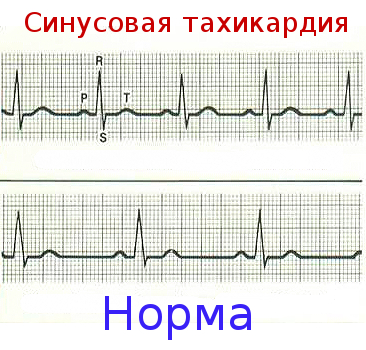Sinus tachycardia
Материал из CardioWiki
Версия от 17:49, 23 марта 2017; Wikiadmin (обсуждение | вклад) (Новая страница: «en:Sinus tachycardia ru:Синусовая тахикардия справа<b>Sinus tachycardia</…»)
Sinus tachycardia is a form of supraventricular tachyarrhythmia, characterized by an accelerated sinus rhythm (i.e., the rhythm of the sinus node) with a heart rate of more than 90 beat per minute in adults.
Clinical value has a sinus tachycardia, which remains at rest. Often it is accompanied by unpleasant sensations of "palpitation", a feeling of lack of air, although some patients may not notice an increase in heart rate. The causes of such a tachycardia can be both extracardiac factors, and actually heart disease.
Sinus tachycardia is characterized by:
- increase in heart rate more than 90 beats per minute;
- maintaining the right sinus rhythm;
- positive P wave in leads I, II, aVF, V4-V6;
- with a pronounced sinus tachycardia, the PQ (R) interval is shortened (but not less than 0.12 s) and the duration of the QT interval is decreased, the amplitude of P wave in the leads I, II, aVF is increased, the amplitude of the T wave is increased or decreased, the oblique ascending depression of S-T segment appears (not more than 1.0 mm below the isoline).


